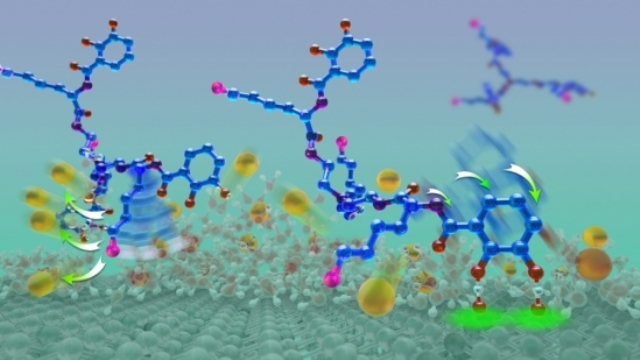Researchers at the Alison Butler Lab of UC Santa Barbara have successfully improved siderophore cyclic trichrysobactin (CTC), a tiny molecule that was previously discovered by them. This molecule can adhere in aqueous environments, and easily binds and transports iron in bacteria and other microorganisms.
 Wet adhesion to a mica surface: A cationic amine (pink) penetrates the hydration layer, evicting potassium ions (gold balls) and preparing the mica surface for hydrogen bonding (green aura). Photo Credit: ILLUSTRATION BY PETER ALLEN
Wet adhesion to a mica surface: A cationic amine (pink) penetrates the hydration layer, evicting potassium ions (gold balls) and preparing the mica surface for hydrogen bonding (green aura). Photo Credit: ILLUSTRATION BY PETER ALLEN
The researchers got their inspiration from the chemical content of mussel foot proteins. After altering the CTC molecule nad studying its adhesive strength in wet environments, they ultimately discovered a compound that matches the sticking power of mussel glue. The study has been published in the journal Science.
Wet adhesion presents a major challenge. Oysters, mussels, barnacles and other marine animals can easily attach themselves to underwater structures such as rocks and buoys and remain firmly in place even in the presence of strong currents and waves. However, synthetic wet adhesive materials are completely different.
“There’s real need in a lot of environments, including medicine, to be able to have glues that would work in an aqueous environment,” said Butler, co-author and professor in UCSB’s Department of Chemistry and Biochemistry. “So now we have the basis of what we might try to develop from here.”
J. Herbert Waite, a professor in the Department of Molecular, Cellular and Developmental Biology, and Jacob Israelachvili’s Interfacial Sciences Lab in UCSB’s Department of Chemical Engineering, were also part of the interdisciplinary research. Waite’s own work is dedicated on wet adhesion.
“We just happened to see a visual similarity between compounds in the siderophore CTC and in mussel foot proteins,” explained Butler. “We specifically looked at the synergy between the role of the amino acid lysine and catechol,” she added. “Both are present in mussel foot proteins and in CTC.”
Similar quantities of catechol dopa and lysine are found in mussel foot proteins. Catechols are chemical compounds that are utilized in biological functions like neurotransmission. However, for adhesive purposes, some proteins have adopted the catechol dopa.
Following discussions with Waite, Butler discovered that the CTC molecule contained both lysine and a compound akin to dopa. Similar to mussel foot proteins, CTC also coupled its catechol with lysine.
“We developed a better, more stable molecule than the actual CTC,” Butler explained. “Then we modified it to tease out the importance of the contributions from either lysine or the catechol.”
Greg Maier, co-lead author and a graduate student in the Butler Lab, produced six types of compounds that had different quantities of catechol and lysine. At the Israelachvili laboratory, each individual compound was examined for its adhesion and surface properties. Michael Rapp, co-lead author, determined the interactions occurring between mica surfaces in a saline solution by means of a surface force apparatus developed at the Israelachvili lab.
It was observed that only two compounds comprising catechol and a cationic amine-like lysine displayed adhesive strength along with a reduced film thickness, the value being equal to the amount to which two surfaces can be squeezed together. Compounds lacking catechol displayed reduced levels of adhesion with equally reduced film thickness, but neither characteristic was observed in compounds without lysine.
“Our tests showed that lysine was key, helping to remove salt ions from the surface to allow the glue to get to the underlying surface,” Maier said.
“By looking at a different biosystem that has similar characteristics to some of the best-performing mussel glues, we were able to deduce that these two small components work together synergistically to create a favorable environment at surfaces to promote adherence,” explained Rapp, a chemical engineering graduate student. “Our results demonstrate that these two molecular groups not only prime the surface but also work collectively to build better adhesives that stick to surfaces.”
”In a nutshell, our discovery is that you need lysine and you need the catechol. There’s a one-two punch: the lysine clears and primes the surface and the catechol comes down and hydrogen bonds to the mica surface. This is an unprecedented insight about what needs to happen during wet adhesion.” Butler concluded.